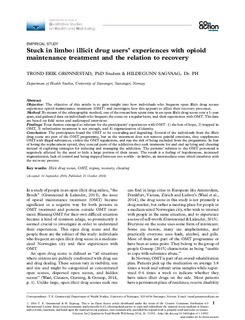| dc.contributor.author | Grønnestad, Trond | |
| dc.contributor.author | Sagvaag, Hildegunn | |
| dc.date.accessioned | 2016-11-25T09:30:28Z | |
| dc.date.available | 2016-11-25T09:30:28Z | |
| dc.date.issued | 2016-10 | |
| dc.identifier.citation | Grønnestad, T. & Sagvaag, H. (2016) Stuck in limbo: illicit drug users’ experiences with opioid maintenance treatment and the relation to recovery. 11: 31992 - http://dx.doi.org/10.3402/qhw.v11.31992 | nb_NO |
| dc.identifier.uri | http://hdl.handle.net/11250/2423016 | |
| dc.description | This is an Open Access article distributed under the terms of the Creative Commons Attribution 4.0
International License (http://creativecommons.org/licenses/by/4.0/), allowing third parties to copy and redistribute the material in any medium or format
and to remix, transform, and build upon the material for any purpose, even commercially, provided the original work is properly cited and states its license.
Citation: Int J Qualitative Stud Health Well-being 2016,
11
: 31992 - http://dx.doi.org/10.3402/qhw.v11.31992 | nb_NO |
| dc.description.abstract | Objective: The objective of this article is to gain insight into how individuals who frequent open illicit drug scenes experience opioid maintenance treatment (OMT) and investigate how this appears to affect their recovery processes.
Method: By means of the ethnographic method, one of the researchers spent time in an open illicit drug scene over a 1-year span, and gathered data on individuals who frequent the scene on a regular basis, and their experiences with OMT. The data are based on field notes and audiotaped interviews.
Findings: Four themes emerged as relevant for the participants’ experiences with OMT: 1) the loss of hope, 2) trapped in OMT, 3) substitution treatment is not enough, and 4) stigmatization of identity.
Conclusion: The participants found the OMT to be overruling and degrading. Several of the individuals from the illicit drug scene are part of the OMT programme, but as the treatment does not remove painful emotions, they supplement OMT with illegal substances, violate the OMT regulations, and run the risk of being excluded from the programme. In fear of losing the replacement opioid, they conceal parts of the addiction they seek treatment for and end up lying and cheating instead of exploring strategies for reducing and managing the addiction. The patients’ relation to the OMT personnel is negatively affected by the need to hide a large portion of their issues. The result is a feeling of hopelessness, increased stigmatization, lack of control and being trapped between two worlds—in limbo, an intermediate state which interferes with the recovery process. | nb_NO |
| dc.language.iso | eng | nb_NO |
| dc.publisher | Co-action publishing | nb_NO |
| dc.rights | Navngivelse 3.0 Norge | * |
| dc.rights.uri | http://creativecommons.org/licenses/by/3.0/no/ | * |
| dc.subject | rus | nb_NO |
| dc.subject | rusavhengighet | nb_NO |
| dc.subject | illicit drug scenes | nb_NO |
| dc.subject | stigma | nb_NO |
| dc.subject | recovery | nb_NO |
| dc.subject | cheating | nb_NO |
| dc.subject | avvenning | nb_NO |
| dc.title | Stuck in limbo: illicit drug users’ experiences with opioid maintenance treatment and the relation to recovery | nb_NO |
| dc.type | Journal article | nb_NO |
| dc.type | Peer reviewed | nb_NO |
| dc.rights.holder | Copyright 2016 T. E. Grønnestad & H. Sagvaag. | nb_NO |
| dc.subject.nsi | VDP::Medical disciplines: 700 | nb_NO |
| dc.source.journal | International Journal of Qualitative Studies of Health and Well-being | nb_NO |
| dc.identifier.doi | 10.3402/qhw.v11.31992 | |

